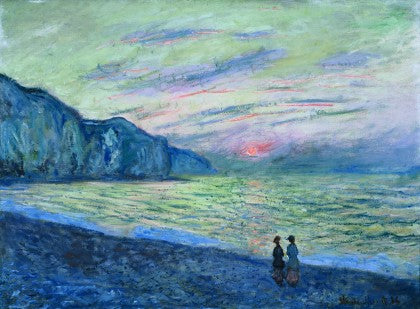Description
Claude Monet's "Sunset at Pourville" (1882) encapsulates one of the most significant virtues of Impressionism: the capture of light and its interaction with natural elements. Monet, the father of the Impressionist movement, was dedicated to this style of painting that seeks to represent visual perception through color and atmosphere, rather than form and line. This painting exhibits all of these characteristics, inviting the viewer to contemplate not only the circumscribed landscape, but also the profound emotion it evokes.
In this work, Monet presents us with a coastal landscape where the sun, already setting, paints the sky with a palette of warm colours; soft shades of orange intertwine with nuances of pink and blue, creating an atmosphere that feels almost ethereal. The strength of the composition lies in its ability to convey the passing of time, at dusk, when the day gives way to the imminent arrival of night.
The structure of the work is composed of a soft division between the sky and the sea, where Monet uses quick and loose brushstrokes that provide a sense of movement and fluidity. The waves, represented in shades of blue and green, seem to dance to the rhythm of a gentle wind. The use of diffused light is masterful, capturing the way the sun reflects on the surface of the water, an effect achieved through the application of small brushstrokes of complementary colors that suggest the glow of the sunset.
Although the painting does not feature human figures, the composition suggests a silent presence. The sailing ships, which loom on the horizon, add depth and a sense of scale to the work, while evoking the serenity and calm often experienced on the coast. These elements can also be interpreted as symbols of freedom and exploration, which often accompany life at sea.
Monet created Sunset at Pourville during his stay in the northern French town, where he found inspiration in the changing light and colour of the coastal landscape. This work is part of a body of work he produced during this period, in which he explored the variations in atmosphere and natural light at different times of the day. It is interesting to note that Monet's contemporaneity and his work in this marine environment is within a broader artistic tradition of the seascape, a subject that had been previously explored by artists such as JMW Turner.
The historical context of this work is also crucial. 1882 is a significant year, in which Monet was fully immersed in experimenting with the techniques that would define his style, such as the bold use of color and the immediacy of the visual experience. In "Sunset at Pourville," Monet achieves a balance between the representational and the abstract, offering the viewer a sensory experience through his ability to evoke emotion through color and light.
In short, “Sunset at Pourville” is one of many works that outline Monet’s mastery in the use of light and color, displaying not only a beautiful landscape, but also the ephemeral essence of the moment captured on his canvas. This painting is not only a testament to his technical ability, but an invitation for viewers to experience an emotional connection with nature and the passage of time, reflected in a calm and sublime coastal atmosphere.
KUADROS ©, a famous painting on your wall.
Hand-made oil painting reproductions, with the quality of professional artists and the distinctive seal of KUADROS ©.
Painting reproduction service with satisfaction guarantee. If you are not completely satisfied with the replica of your painting, we will refund 100% of your money.

